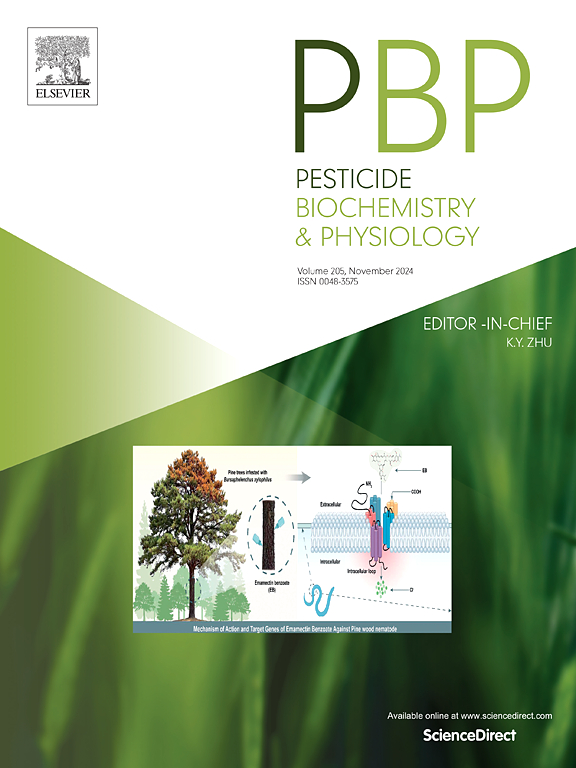脊髓同步蛋白抵抗与交叉抵抗- 25年回顾与分析
IF 4.2
1区 农林科学
Q2 BIOCHEMISTRY & MOLECULAR BIOLOGY
引用次数: 0
摘要
spinosyns是在25年前引进的(spinosad - Qalcova™活性,1997年),后来又引进了spinetoram (Jemvelva™活性,2007年),用于控制各种害虫,特别是鳞翅目和蓟马。虽然IRM准则是在引进时制定的,但有一些过度使用的情况,导致几种害虫物种产生抗药性。此外,实验室选择脊髓旋合蛋白抵抗是研究脊髓旋合蛋白作用方式的工具。作为了解对spinosyns抗性范围的持续努力的一部分,分析了400项研究,涵盖1100个病例,其中检查了spinosyns的抗性(现场或实验室研究),或检查了spinosyns对其他杀虫剂的交叉抗性。迄今为止,已经调查了400例自旋肽选择抗性,其中一半在田间菌株中,只有少数与次优控制有关。大多数田间选择性抗棘虫的病例涉及蓟马(46%)、鳞翅目(22%)和双翅目(18%)。重要的是,只有一小部分现场选择的spinsyn抗性病例显示出高水平的抗性(>;1000倍),许多(约30%)表现出没有或有限的抗性水平。与其他杀虫剂(如新烟碱类、阿维菌素二胺、拟除虫菊酯)的交叉抗性没有相关性。对400多项研究的分析表明,其他杀虫剂也不太可能对spinosyns产生交叉抗性,这可能是由spinosyns独特的化学成分和新的作用模式驱动的。因此,自旋蛋白抵抗的总体影响远小于过去25年大量不断扩大的研究所暗示的影响。本文章由计算机程序翻译,如有差异,请以英文原文为准。

Spinosyn resistance and cross-resistance – A 25 year review and analysis
The spinosyns were introduced more than 25 years ago (spinosad - Qalcova™ active, 1997) and later followed by spinetoram (Jemvelva™ active, 2007), for the control of a wide range of pest insects, especially lepidopterans and thrips. Although IRM guidelines were initiated at the time of introduction, there have been some cases of overuse, resulting in resistance development in several pest insect species. Additionally, laboratory selection for spinosyn resistance has been a tool to investigate the mode of action of the spinosyns. As part of an ongoing effort to understand the scope of resistance to the spinosyns, >400 studies covering >1100 cases were analyzed where resistance to the spinosyns was examined (field or laboratory studies) or spinosyns were examined for cross-resistance to other insecticides. To date there have been 400 cases where spinosyn-selected resistance was investigated, with half in field strains of which only a few were associated with sub-optimal control. Most cases of field selected spinosyn resistance involved thrips (46 %), lepidopterans (22 %) or dipterans (18 %). Importantly, only a small percentage of the field selected spinosyn resistance cases show high levels of resistance (>1000-fold), with many (∼30 %) exhibiting either no or limited levels of resistance. There was no correlation in spinosyn-selected insects for cross-resistance to other insecticide classes (e.g. neonicotinoids, avermectins diamides, pyrethroids). Analysis of 400+ studies indicates that cross-resistance to the spinosyns from other insecticides is also unlikely, potentially driven by the unique chemistry and novel mode of action of the spinosyns. Thus, the overall impact of spinosyn resistance is far less than might be implied from the large and expanding body of studies over the last 25 years.
求助全文
通过发布文献求助,成功后即可免费获取论文全文。
去求助
来源期刊
CiteScore
7.00
自引率
8.50%
发文量
238
审稿时长
4.2 months
期刊介绍:
Pesticide Biochemistry and Physiology publishes original scientific articles pertaining to the mode of action of plant protection agents such as insecticides, fungicides, herbicides, and similar compounds, including nonlethal pest control agents, biosynthesis of pheromones, hormones, and plant resistance agents. Manuscripts may include a biochemical, physiological, or molecular study for an understanding of comparative toxicology or selective toxicity of both target and nontarget organisms. Particular interest will be given to studies on the molecular biology of pest control, toxicology, and pesticide resistance.
Research Areas Emphasized Include the Biochemistry and Physiology of:
• Comparative toxicity
• Mode of action
• Pathophysiology
• Plant growth regulators
• Resistance
• Other effects of pesticides on both parasites and hosts.

 求助内容:
求助内容: 应助结果提醒方式:
应助结果提醒方式:


